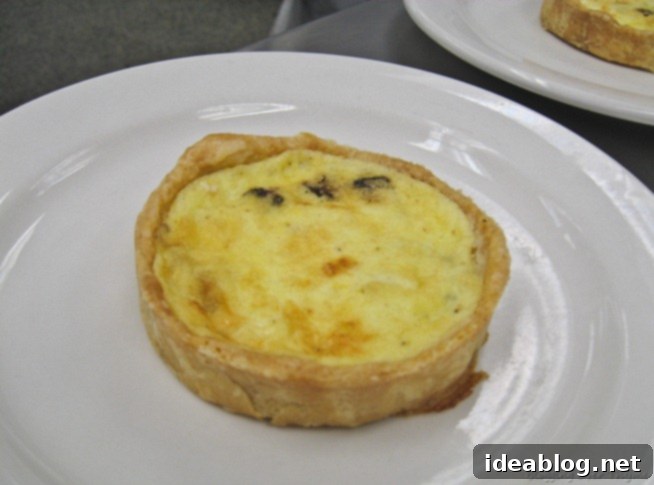Exploring Culinary Excellence: A Day of French Classics, From Marjolaine to Chicken Roulade
Every day in culinary school presents a fresh opportunity to delve deeper into the intricate world of classic French cuisine, and today was no exception. It was a bustling, fast-paced session in the kitchen, filled with both challenges and immensely rewarding creations. From the delicate artistry of a beloved dessert to the technical demands of a sophisticated main course, our culinary journey continues to unfold, sharpening our skills and expanding our understanding of gastronomic excellence.
The Grand Finale: Marjolaine Cake, A French Patisserie Masterpiece
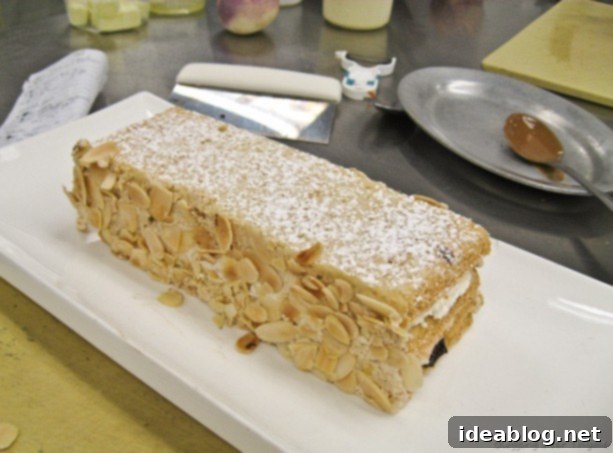
Without a doubt, the highlight of our culinary day was the dessert: a truly magnificent Marjolaine Cake. This iconic French patisserie item is a testament to the elegant simplicity and rich flavors that define classic baking. At its heart, the Marjolaine is a dacquoise cake, an exquisite base composed of a French meringue blended with finely ground nuts—in our case, premium almond flour. This foundation creates a light, airy, yet subtly chewy texture that is utterly delightful.
The beauty of the Marjolaine truly shines through its meticulously layered fillings. We meticulously alternated between a luxurious dark chocolate ganache, a velvety smooth hazelnut cream, and a classic, fragrant vanilla cream. Each layer brought its own distinct profile, from the deep bitterness of the chocolate to the nutty warmth of the hazelnut and the sweet, aromatic embrace of vanilla. This intricate combination of textures and tastes ensures a balanced and truly memorable sensory experience with every forkful.
To finish this masterpiece, the cake was delicately dusted with powdered sugar, creating a beautiful snowy top, and elegantly garnished with thin, toasted almond slices. These not only added a touch of visual sophistication but also provided a delightful textural contrast and an extra layer of nutty flavor. I was particularly impressed by how incredibly moist and rich this cake turned out, and the hazelnut flavor was wonderfully pronounced—a personal favorite! It has easily become my top dessert discovery so far in Phase I of our program, and I am already anticipating the joy of recreating this exquisite cake again in the future, perhaps even experimenting with different nut combinations or flavor profiles for the creams.
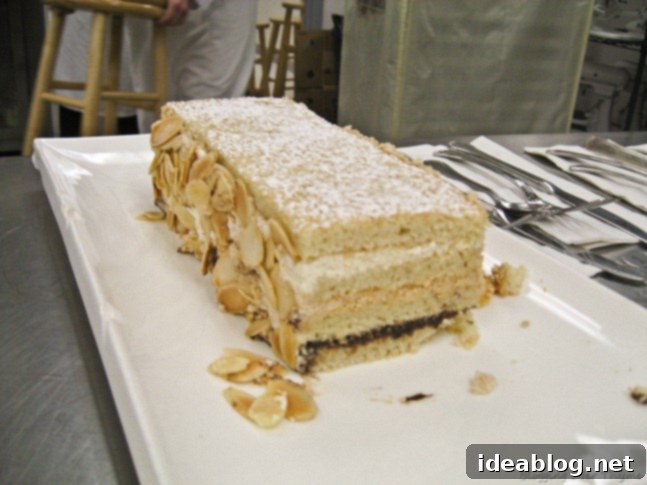
A Savory Return: Reaffirming Skills with Classic Quiche Lorraine
For our appetizer, we revisited a foundational dish from early in Phase I: the timeless Quiche Lorraine. This beloved savory tart originates from the Lorraine region of France and is a quintessential example of French comfort food elevated to an art form. It features a tender, flaky pâte brisée crust, which we crafted to perfection, ensuring it held its shape and provided a crisp counterpoint to the rich filling.
The filling itself is a classic combination of a delicate, creamy custard, generously studded with savory Gruyère cheese and crispy, smoky bacon (or lardons, as they are traditionally known). Revisiting this dish allowed us to reinforce fundamental techniques, from achieving the ideal consistency for the pastry dough to perfecting the delicate balance and texture of the custard. The experience served as an excellent refresher on core culinary principles. Given its significance, there’s a strong indication that this very dish might make an appearance on our upcoming exam this Thursday, making today’s practice invaluable for solidifying our mastery of this essential French staple.
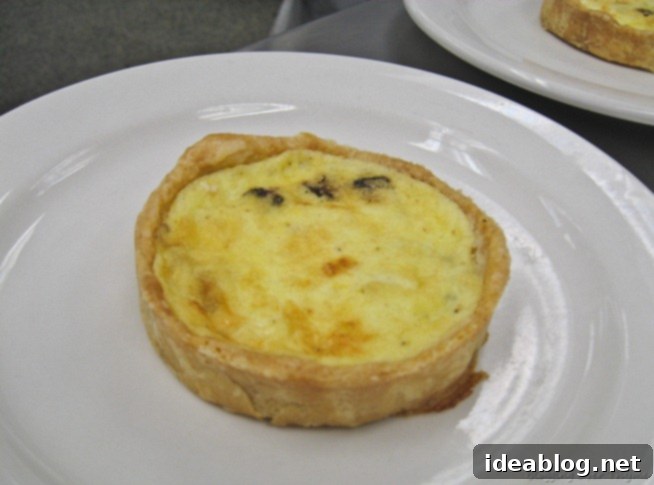
The Main Event: Technical Chicken Roulade with Mousse
Our main course for the day presented a fascinating and technically demanding challenge: a sophisticated chicken roulade. This dish requires precision and a multi-faceted understanding of various culinary processes. We started with tenderized chicken breasts, carefully pounded thin to create a uniform canvas for our flavorful stuffing. The filling consisted of vibrant roasted bell peppers, delicately sautéed spinach, and a unique element: chicken mousse.
Interestingly, today’s chicken mousse was prepared using chicken leg meat, a departure from the breast meat we’d used in previous mousse applications. While the leg meat imparts a richer flavor, it also demands significantly more time and effort to process into a smooth, emulsified mousse. The concept of stuffing chicken with chicken might initially strike one as slightly redundant, and I must admit, I shared that initial thought. Even our Chef acknowledged the unusual nature of this particular combination, noting that while it might not be a common offering in most restaurants, its true value lies in the sheer number of different techniques it requires us to master and integrate seamlessly. This dish was less about culinary logic and more about pushing the boundaries of our technical skill set.
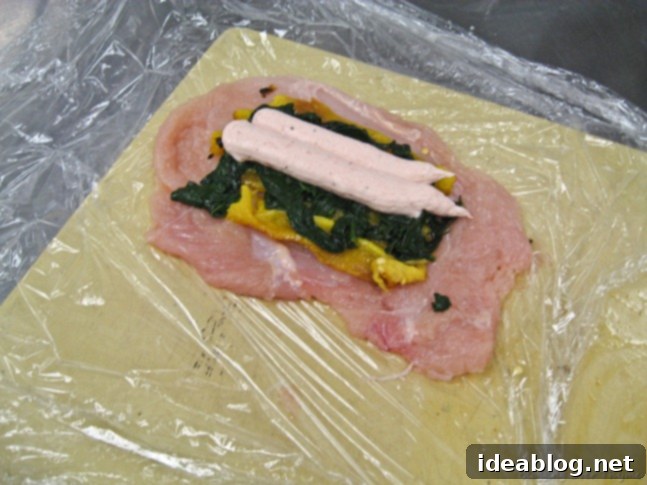
The preparation of the roulade involved several critical steps. After carefully assembling the filling onto the pounded chicken breast, we rolled it up very tightly and securely in plastic wrap, twisting the ends to form a compact, sausage-like shape. This tight rolling is crucial for maintaining the roulade’s form during cooking and ensuring a uniform end product. Next, we gently pricked the plastic wrap a few times with a knife to allow steam to escape and then poached the roulade in barely simmering water. This gentle poaching method is key to cooking the chicken through evenly while keeping it incredibly moist and setting the mousse without drying out the delicate ingredients.
Once the roulade was properly set and cooked through, we carefully unwrapped it. The final step involved pan-searing the roulade in a hot sauté pan. This crucial stage adds a beautiful golden-brown color to the exterior, develops a delicious caramelized crust, and locks in all the succulent flavors, completing the cooking process with an appealing finish. What was particularly satisfying about this rendition, unlike some of our earlier chicken mousse dishes, was how subtly the mousse integrated. It truly enhanced the texture of the filling without overwhelming the other flavors, making the dish surprisingly harmonious. Once sliced, it revealed an elegant spiral of chicken, roasted pepper, and spinach, bound by the delicate mousse, as seen in the accompanying image.
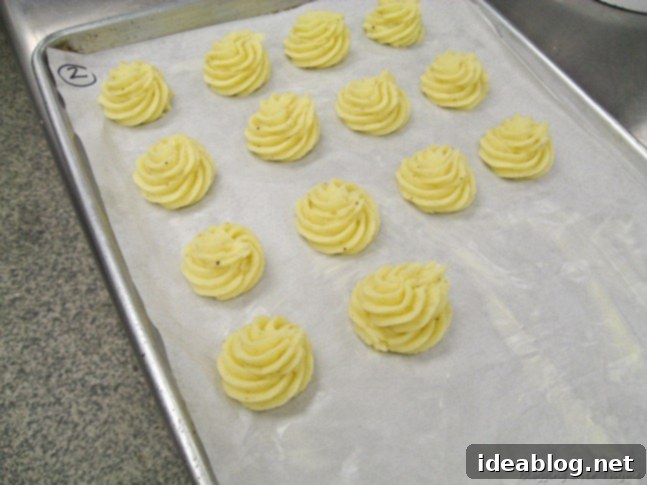
To complement the chicken roulade, we prepared a simple yet incredibly flavorful, thin jus. This classic accompaniment was made by simmering roasted chicken bones with aromatic mirepoix (a foundational mix of diced carrots, celery, and onions) and quality chicken stock, reducing it to a rich, concentrated liquid that accentuated the flavors of the main course without overpowering them.
Side Dish Elegance: Pommes Duchesse
Alongside the roulade, we also crafted pommes duchesse, an exquisite and visually stunning potato dish that instantly elevates any plate. This is another new potato preparation for us, showcasing an elegant technique. Pommes duchesse begins with perfectly cooked potatoes, which are then passed through a ricer to achieve an incredibly smooth, lump-free consistency. This riced potato is then combined with a small amount of whole egg and an extra yolk, providing richness, color, and binding properties. A touch of butter and careful seasoning complete the mixture. The prepared potato mixture is then piped through a star-tipped pastry bag into delicate, decorative rosettes. These rosettes are chilled to firm up their shape before being baked in a hot oven until they are beautifully golden-brown and slightly crispy on the edges. The visual appeal is undeniable, and the piping process delightfully reminded me of frosting countless cupcakes in my earlier days—a wonderful connection between savory and sweet culinary skills.
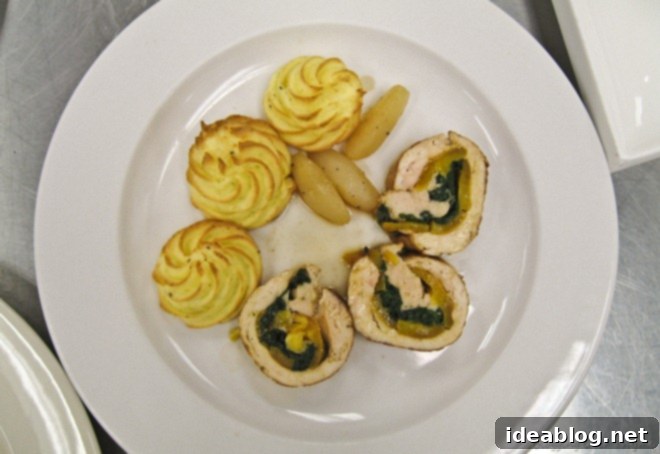
Mastering Knife Skills: Glazed (Tournéed) Turnips
Our vegetable accompaniment for the day consisted of simple yet elegantly prepared glazed (tournéed) turnips. The term “tournéed” refers to the classical French technique of shaping vegetables into uniform, seven-sided oval barrels, a skill that demands considerable knife precision and practice. While the tournéing process can still be time-consuming, I’ve noticed a significant improvement in my speed and consistency—it truly becomes exponentially easier with repetition. This technique not only ensures even cooking but also contributes significantly to the aesthetic presentation of the dish.
The turnips were then cooked using a familiar glazing method we’ve applied to many other vegetables, such as potatoes and carrots. They are added to a pan with a small amount of butter, seasoned with salt and pepper, and covered with a very thin layer of chicken stock. A parchment paper lid (cartouche) is placed directly on top to create a gentle steaming environment, and the vegetables are cooked over very low heat until they are tender and almost all the liquid has been absorbed, leaving them beautifully coated in a glossy, flavorful glaze. This familiar process underscores the importance of foundational techniques and their versatile application across various ingredients.
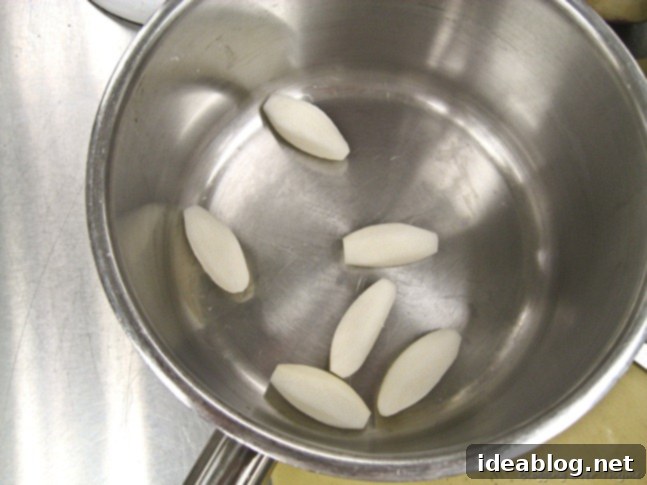
Reflections and Future Culinary Adventures
And that, in essence, summarizes our intensive culinary day. While the images might not fully capture the complexity and pace of our kitchen work, it was undeniably a day packed with learning, skill refinement, and the creation of remarkably tasty dishes. Each course, from the sweet elegance of the Marjolaine to the technical challenges of the chicken roulade and the classic accompaniments, contributed significantly to our understanding and mastery of classical French techniques.
As Phase I draws to a close, the anticipation for Phase II, which begins next week, is palpable—and a little daunting! The thought of new challenges and more advanced techniques is both exciting and a touch intimidating. But for now, my focus remains squarely on preparing for Thursday’s exam, which will test our accumulated knowledge and practical skills. Keep an eye out for another update this weekend, as I’ll be sharing more insights from our ongoing culinary adventure!
